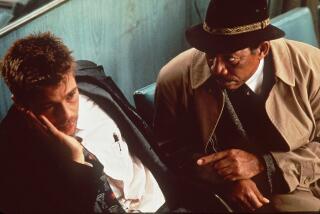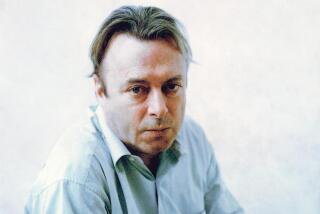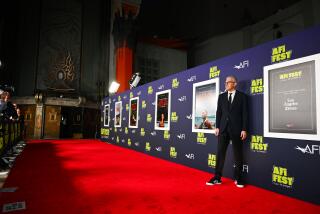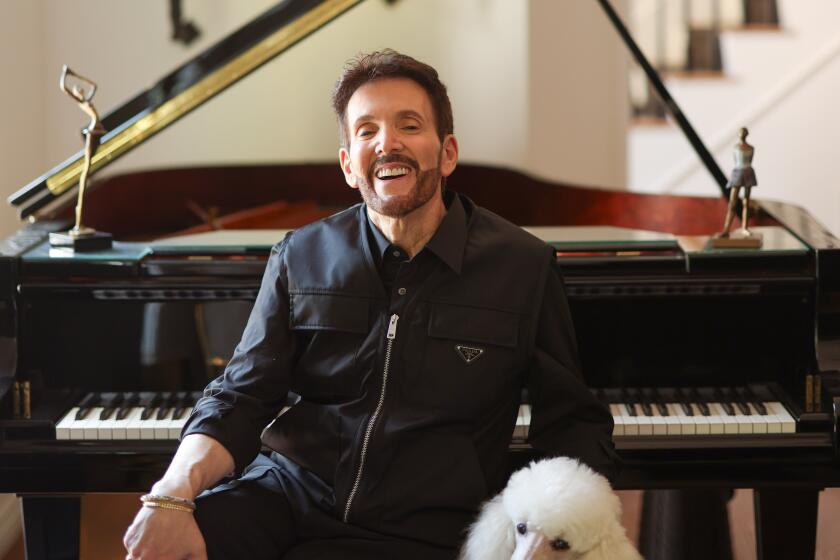The chillingly contemporary Alfred Hitchcock
There’s but one problem with welcoming Alfred Hitchcock back to the public eye: He’s never really been away. But even if you grant that the director is a man for all of cinema’s seasons, what is it about him that makes this moment in time so indisputably his?
Within little more than a month, two dramatic films with Hitchcock as the protagonist will have graced screens: HBO’s “The Girl” looks at the director (played by Toby Jones) during the making of “The Birds,” while Fox Searchlight’s “Hitchcock” goes back a few years earlier to examine the creation of “Psycho” with Anthony Hopkins in the title role.
FOR THE RECORD:
Alfred Hitchcock: A Critic’s Notebook in the Nov. 11 Calendar section about filmmaker Alfred Hitchcock referred to British critic Michael Wood. The critic’s name is Robin Wood. —
Not only has Universal just released a handsome “Alfred Hitchcock: The Masterpiece Collection” boxed set bringing 13 of his films to Blu-ray for the first time, but one of those motion pictures, 1958’s “Vertigo,” was just named the greatest film of all time in British film magazine Sight & Sound’s highly regarded international critic’s poll, knocking “Citizen Kane” off that perch for the first time in decades.
PHOTOS: ‘Hitchcock’ premiere at AFI Fest
In Britain, where Hitchcock was born, the frenzy is even more intense. The British Film Institute has successfully launched a fund-raising campaign puckishly called “Rescue the Hitchcock 9” in order to restore the director’s surviving silent films — one of those, the 1927 boxing drama “The Ring,” showed to turn-away crowds this year at Cannes — and a complete BFI retrospective of all his 50-plus features was accompanied by an admiring critical compendium entitled “39 Steps to the Genius of Hitchcock.”
“Of all the great directors,” critic James Bell writes in that book’s introduction, “it is Hitchcock who above all has come to embody the cinema to people across the world. More than any other, he’s the figure upon whom every film lover can agree — his work is as popular and as present in the Film Studies classroom as it is in cinemas and DVD collections.”
In a way, Hitchcock, who died in 1980 at the age of 80, is in effect the cinematic equivalent of Elvis: He’s never needed to be reintroduced to succeeding generations of filmgoers. They simply pick up on his pervasive presence in the cultural atmosphere. On the other hand, his work wasn’t always held in the esteem it is today.
PHOTOS: Alfred Hitchcock: Career snapshots
What helped Hitchcock’s popularity is that while he was alive he took the very modern stance of cultivating his public image to the maximum extent possible. He made sure to make cameo appearances in each of his films — a bus door amusingly closes in his face in “North by Northwest,” for instance — and his rotund silhouette and mordant sense of humor became familiar to millions of Americans during the seven years (1955-1962) his “Alfred Hitchcock Presents” anthology program appeared on the CBS network.
Not only did Hitchcock, in order to enhance box office returns, nurture this cult of personality around himself, but, like science fiction writer Philip K. Dick, he also had a sensibility that feels particularly modern.
Deadpan, acerbic, the opposite of sentimental, Hitchcock had a way of looking at the world that would give Tim Burton a run for his ghoulish money. Even the undeniably sadistic streak that ran through his personality has an appeal to modern tastes, as witness the fact that it is front and center in both “The Girl” and “Hitchcock.”
It also helped his prominence that though he worked in other genres from time to time, Hitchcock was the acknowledged master of the kind of thrillers that are hugely popular today both with readers and moviegoers. If “The Girl With the Dragon Tattoo” had been published while he was in his prime, the film rights might have been his for the asking.
Another quality that makes Hitchcock a figure of continuing interest is the amount of craft, acquired by directing dozens of pictures over five decades and consequently rare today, he brought to the table. Hitchcock was a master of every detail of the filmmaking process, meticulous enough to have “Vertigo” star Kim Novak practice some of her movements to a metronome. He liked to pretend that his films were so meticulously planned that the actual filming was a secondary pleasure.
His solution to simulating the vertigo of the title, done by having the camera simultaneously zoom in and track out, was the result, he told fellow director Francois Truffaut, of 15 years of thinking about how best to show dizziness on screen.
The biggest factor in Hitchcock’s current prominence, however, is that there were elements of his work that seem more suited to today’s film world than his own. “Vertigo” is a good example of this; its spot atop the Sight & Sound poll notwithstanding, even with its brilliant Bernard Hermann score, this motion picture was more or less dismissed by critics at the time of its initial release.
“Another Hitchcock-and-bull story,” sneered Time magazine. The New Yorker said the director “has never before indulged in such far-fetched nonsense,” and this newspaper lamented that the film “bogs down in a maze of details.” Even partisans conceded that this was minor Hitchcock at best.
And seven years later, when iconoclastic British critic Michael Wood had the temerity to call “Vertigo” “one of the four or five most profound and beautiful films the cinema has yet given us,” he made sure to follow his statement with the acknowledgment that “this is a claim that may surprise, even amuse, the majority of my readers.”
A disturbing meditation on the interconnected nature of love and obsession disguised as a penny-dreadful shocker, “Vertigo” (a personal favorite) and Hitchcock’s work in general, resonate powerfully with current audiences because of several interconnected factors.
For one thing, the 1960s French New Wave, the rise of independent film and the proliferation of academic film studies have combined to give considerable cachet to the notion of subjective moviemaking. And though it was made in the heart of the studio system, for Universal, “Vertigo”’ is as intensely personal as any entry at Sundance, with some of the biggest stars of the day helping Hitchcock work through the nakedest version of his perennial fascinations with glacial blonds and the ghastly jokes of fate.
What also connects impressively to modern audiences is the strange darkness of “Vertigo’s” themes, its moments of obsessive eroticism, its tipping of the hat to sadism, masochism, fetishism, necrophilia and more garden-variety neuroses.
Hitchcock’s ability to unsettle and disconcert — without resorting to today’s torture-porn style visuals — underlines how timeless his preoccupations and themes remain.
PHOTOS AND MORE
VIDEO: What to see during Thanksgiving weekend
The Envelope: Awards Insider
PHOTOS: NC-17 movies: Ratings explained
More to Read
Only good movies
Get the Indie Focus newsletter, Mark Olsen's weekly guide to the world of cinema.
You may occasionally receive promotional content from the Los Angeles Times.











